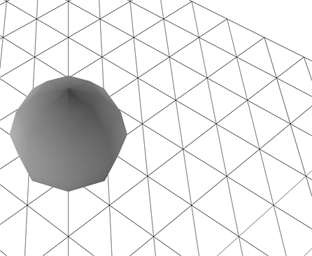Actionscript:
-
import com.actionsnippet.qbox.*;
-
import Box2D.Common.Math.*;
-
-
stage.frameRate = 60;
-
-
var sim:QuickBox2D = new QuickBox2D(this);
-
-
sim.createStageWalls();
-
-
createTraveler(3, 3);
-
-
addObstacles();
-
-
function addObstacles():void{
-
sim.setDefault({groupIndex:-1, density:0, height:0.4});
-
sim.addBox({x:6, y:5, width:8, angle:0.17})
-
sim.addBox({x:7, y:7.1, width:8, angle:-0.17})
-
sim.addBox({x:5, y:9.1, width:8, angle:0.10})
-
sim.addBox({x:6, y:11.5, width:8.9, angle:-0.20})
-
sim.addBox({x:5.5, y:16, width:9, angle:0.20})
-
sim.addBox({x:5.5, y:18, width:9})
-
sim.addCircle({x:11, y:20, radius:2.5, groupIndex:1});
-
sim.addBox({x:16, y:19, width:2, height:2, angle:0.0, groupIndex:1})
-
}
-
-
function createTraveler(x:Number, y:Number):QuickObject{
-
var parts:Array = [];
-
parts[0] = sim.addCircle({x:0, y:1, radius:0.25, friction:0.01});
-
parts[1] = sim.addCircle({x:0, y:3, radius:0.25, friction:0.01});
-
parts[2] = sim.addBox({x:0, y:2, width:0.3, height:1.5 , groupIndex:-1});
-
return sim.addGroup({objects:parts, x:x, y:y });
-
}
-
-
sim.start();
-
sim.mouseDrag();
One of the more advanced and useful properties of rigid bodies is the groupIndex. It allows you to specify which rigid bodies collide with one another and which rigid bodies pass through one another. This snippit demo's the groupIndex property. For more information take a look at what the Box2D manual says.
Take a look at the swf here.
Actionscript:
-
[SWF(width=560,height=300,backgroundColor=0x000000,frameRate=30)]
-
-
var key:Object = new Object();
-
var alphabet:Array = "abcdefghijklmnopqrstuvwxyz".split("");
-
-
var num:Number = alphabet.length;
-
var step:Number = 360 / num;
-
-
var colors:Object = new Object();
-
for (var i:int = 0; i<num; i++){
-
var index:String = alphabet[i];
-
key[index] = 65 + i;
-
var c:Array = hsv(i * step, 1, 1);
-
colors[index] = c[0] <<16 | c[1] <<8 | c[2];
-
}
-
alphabet.push("32");
-
num++;
-
key["32"] = 32;
-
colors["32"] = 0x333333;
-
x = y = 10;
-
var count:int = 0;
-
var size:int = 20;
-
stage.addEventListener(KeyboardEvent.KEY_DOWN, onKeyPressed);
-
function onKeyPressed(evt:KeyboardEvent):void{
-
for (var i:int= 0; i<num; i++){
-
var index:String = alphabet[i];
-
if (index == "32"){
-
trace("hi", evt.keyCode, key[index]);
-
}
-
if (evt.keyCode == key[index]){
-
graphics.beginFill(colors[index]);
-
var xp:int = count % num * size;
-
var yp:int = int(count / num) * size;
-
graphics.drawRect(xp, yp, size, size);
-
count++;
-
}
-
}
-
}
-
// ported from here:
-
//http://www.cs.rit.edu/~ncs/color/t_convert.html
-
function hsv(h:Number, s:Number, v:Number):Array{
-
var r:Number, g:Number, b:Number;
-
var i:int;
-
var f:Number, p:Number, q:Number, t:Number;
-
if (s == 0){
-
r = g = b = v;
-
return [Math.round(r * 255), Math.round(g * 255), Math.round(b * 255)];
-
}
-
h /= 60;
-
i = Math.floor(h);
-
f = h - i;
-
p = v * (1 - s);
-
q = v * (1 - s * f);
-
t = v * (1 - s * (1 - f));
-
switch( i ) {
-
case 0:
-
r = v, g = t, b = p;
-
break;
-
case 1:
-
r = q, g = v, b = p;
-
break;
-
case 2:
-
r = p, g = v, b = t;
-
break;
-
case 3:
-
r = p, g = q, b = v;
-
break;
-
case 4:
-
r = t, g = p, b = v;
-
break;
-
default: // case 5:
-
r = v, g = p, b = q;
-
break;
-
}
-
return [Math.round(r * 255), Math.round(g * 255), Math.round(b * 255)];
-
}
This snippet is a typing experiment - for every letter, you type a box filled with a specific color is drawn to the stage. The color associated with each letter is determined by moving through hsv color space - so typing an alphabet will end up with something resembling a spectrum.
Actionscript:
-
function dotSyntax(target:*, path:String):* {
-
var level:Array=path.split(".");
-
var curr:* = target;
-
for (var i:int = 0; i<level.length; i++) {
-
curr=curr[level[i]];
-
}
-
return curr;
-
}
-
-
trace(dotSyntax(this, "stage.stageWidth"));
-
trace(dotSyntax(this, "graphics"));
-
trace(dotSyntax(this, "root.loaderInfo.bytesTotal"));
-
-
/*outputs something like:
-
800
-
[object Graphics]
-
1230
-
*/
This snippet shows how to parse dot syntax from a string. It does this by splitting the string and then using square bracket syntax. This is one of the main techniques that makes yesterdays post possible.
XML:
-
<code>
-
<make reference="w" class="BasicView" args="stage.stageWidth, stage.stageHeight, false"/>
-
<call method="addChild" args="w"/>
-
-
<make reference="wireMat" class="WireframeMaterial" args="0x000000" />
-
-
<make reference="sphere" class="Sphere" args="wireMat, 100" />
-
-
<call method="w.scene.addChild" args="sphere" />
-
-
<make reference="animation" class="Object">
-
<set z="-500" rotationY="360" rotationX="360" ease="Back.easeOut"/>
-
</make>
-
-
<call method="TweenLite.to" args="sphere, 3, animation" />
-
-
<call method="setInterval" args="w.singleRender, 32" />
-
-
</code>
This snippet shows XML that the mini-library AsXML can read and run - in this case AsXML is set up to run with Papervision
A few days ago I had the idea to write some code that would run ActionScript based on XML. I spent some time getting rid of a few bugs and setting up some demos with TweenLite, Papervision and QuickBox2D. I wrapped everything up into a mini-library called AsXML.
Check out the demos here.

Download AsXML and demo files here.
AsXML Features:
1) call methods of the main timeline
2) read and write properties on the main timeline
3) instantiate classes on the main timeline
4) call methods on these classes
5) read and write properties on these classes
6) store references to return values from functions
Posted in Box2D, Graphics, Math, QuickBox2D, XML, dynamic, external data, instantiation, misc, motion, return values, string manipulation, strings | Tagged actionscript, as3, flash |
